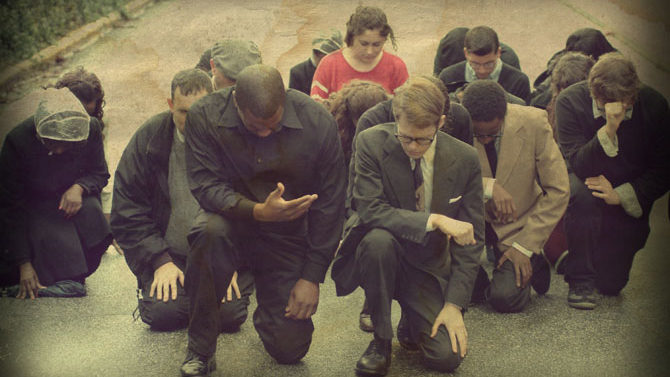How it feels to watch a friend die in the street. How to train yourself not to hate someone who is beating you with a nightstick. How good for the soul it is to share a meal and laughter with people like you who have just been spit on, blasted with fire hoses and yelled at for taking part in a march. How singing a song can give you courage and hope.
These are some of the experiences captured in Keith B. Plummer’s new documentary, Before the Memories Fade: Voices from the Civil Rights Movement. The film is having its local premiere at the historic Morton Theatre on Thursday, Feb. 28. Tickets can be purchased at the box office or at www.beforethememoriesfade.com.
Local viewers will recognize a few places and faces. Reenactment scenes were shot on Reese Street, next to the AT&T building and behind Marti’s at Midday on Prince Avenue. Students from University of Georgia theater program are in the cast, as are a handful of townies.
While it includes interviews with prominent civil rights figures like U.S. Rep. John Lewis, Rep. Eleanor Holmes Norton, Dr. Benjamin Hooks and the Rev. Walter Fauntroy, the heart of the film is the firsthand stories told by comparatively unsung foot soldiers of the movement: the students, ordinary citizens, community organizers and musicians who risked a lot to do what was right.
For Plummer, an Athens resident and a former television news photographer who now makes documentaries, this project took on a special urgency.

Keith Plummer
“Many people—both those who are now famous and those much less known—are approaching their 50th anniversary of participation in the Civil Rights Movement,” Plummer says. “I wanted to record them telling their stories in their own words while I still had the chance.”
In this interview, Plummer talks about the challenges of making this film and about what he learned about the complexities of the Civil Rights Movement. (Full disclosure: Plummer is a friend, and I make my debut as an extra in this film.)
Flagpole: What motivated you to make this film now?
Keith Plummer: The idea came to me over 15 years ago, when I was interviewing the Rev. Walter Fauntroy. [Fauntroy, part of Dr. Martin Luther King’s Southern Christian Leadership Conference, helped organize the 1963 March on Washington where King delivered his “I Have a Dream” speech.]
Back then, I was a television news cameraman, and we were doing a story dealing with church fires. Remember, there were a string of churches being burned down in the South at the time. After the interview, when I was getting my gear back, I looked at him and I said, “You know, I don’t know if I could have done the things you guys did during the Civil Rights Movement. It was a different time, and maybe I could have, and maybe I couldn’t.”
He looked at me and he said, “Keith, let me tell you something. What we did during the Civil Rights Movement, it went like this: When the cameras were rolling, we took the butt-whipping. But when the cameras were off…” and then he smiled. And I said, “Nobody ever tells you that story; nobody ever tells you that there was something else that went on.” And so I said, “One day, whenever I had the chance, I would do that story.”
And then one day, after I had left television and had started my own production company, I was reading the paper and started noticing that a lot of civil rights people were passing. I figured that somebody else would have done this story, but then I realized nobody had. So, basically, I just started calling people up—sending emails and letters—asking if they’d let me interview them.
FP: Was it easy getting interviews?
KP: No. One of the hardest things in making this film was getting the people. I sent out over a hundred letters and emails trying to get people. Famous people have press secretaries, and they have numbers out that you can get to, so it’s not so hard to make contact with them. But because I wanted to talk to the foot soldiers of the movement, too—that was harder. Who are they? You have to have people tell you who they are, and sometimes they’ve got a number, and sometimes they don’t.
But it worked out. It kind of daisy-chained. Once I got one person and I got their confidence, then I could go to another person, and they would refer me to someone else. And sometimes they say yes, and sometimes they say no.
I had to deal with the fact that a lot of people thought they were taken advantage of after the movement. A lot of people made money off of photos of them and their voices and their whole experience, and they, they didn’t get anything. So, people were leery. And I understood that. I understood that if you said no, you said no. I got letters from people who I really wanted to get, who just wished me well. And then other people, even though they seemed like they wanted to do it, we could never hook up in time.
FP: You interviewed lots of people in their 70s, 80s and 90s. What was that like?
KP: I was able to get one of the last interviews with Dr. Benjamin Hooks before he passed. That was important. [Hooks, a pioneering civil rights lawyer, helped organize restaurant sit-ins and other boycotts.]
And I got the last interview with Dr. Dorothy Height. [Height was president of the National Council of Negro Women from 1957 to 1997 and organized dialogue meetings between black and white women during the key years of the Civil Rights Movement.]
One of the important things about the movie is basically the title, and it’s a long title: Before the Memories Fade: Voices from the Civil Rights Movement. Fading is not just about people’s memories fading; it’s about people passing. You know, these are things we need to remember, and it’s a part of history. It is history.
A big part of the movie’s structure takes its cue from the way older people speak. I say this respectfully: They don’t often speak in sound bites. They talk and it leads to somewhere else. And this is kind of the way the movie goes. It travels from one place to another. It may not be sound bites, but it has a direction.
One thing I heard over and over from people involved in the movement was, “People always edit what we say, so that’s why we don’t talk about it much.” So, I made a conscious decision that, whenever possible, I was going to let what they had to say be what they had to say, and not chop it up, and not do a lot of serious editing.
I did have to edit. I wound up with so much footage, so many stories. I interviewed over 35 people, and trying to fit all of them and their whole stories… I remember while I was going over the footage, I kept saying, “Oh, this is great, oh, this is great; I have to keep that in.” Originally, I was aiming to make a 90-minute film, but at one point, I had 150 minutes of material that I thought was great. So, I had to edit it down. But I tried to give them the time they needed. I still have a bunch of stories that didn’t make the final cut. I want to be able to put them out there on a website someday soon.
FP: You don’t use a lot of clips from historical footage in your film. Why is that?
KP: For a while, I was trying to find footage that people had taken during the movement. I’d ask people if they happened to have any still photos or any Super 8 footage. And they’d say, “Are you kidding? If we had a camera, that could be taken and used as evidence.” They told me they generally didn’t take any valuables when they went on those marches or sit-ins. And that makes sense when you think of it.
After lining up the people for interviews, the hardest problem in making a historical documentary on a small budget is securing rights for footage—and civil rights footage is very expensive.
Then there’s general stock footage. They charge you $35 a second, or a $100 a second. There are photos that cost $350 for a single use. That gets to be a lot of money.
So, I had to get a little more creative and use illustrations, animations and reenactments. The movie has reenactments shot in HD, in Super 8, and it has original footage.
FP: Explain a little more about your choice to do reenactments.
KP: You have to remember that part of doing this film is realizing that you have to make a connection with young people to a time that they have no clue about, and doing the reenactments was part of that. I wanted to make sure that younger people got to see, got to get an understanding of what it was like to be in the movement. So, the reason for doing the reenactments was, one, to cut down on costs and, two, to help to teach people, especially young people.
Whenever we did reenactments, I would sit there and tell the actors—a lot of them were UGA theater students—this is what happened here. When you tell them that the people that they are reenacting were their age, except that they were going through this for real, it makes a little bit of a difference. A big difference, really. That’s pretty intense.
FP: How did your perspective on the Civil Rights Movement change as you made this film?
KP: I wanted to make sure that I was able to tell the story that people—including me—don’t often hear. So, this movie has icons of the movement, and it has the foot soldiers, the everyday people. And one of the big things that struck me is that you could have two people in the movement being polar opposites on some issues or experiences. There’s a part in the movie where you have Dr. Hooks talking about how great the meals were and all this stuff, and then you have Dave Dennis, who was a foot soldier working out in the field, saying they used to go out and try to register people to vote at five o’clock in the evening because that was when people were at home having dinner.
That’s a small disparity, but there are bigger ones.
We tend to look at the movement as a nonviolent movement, and as a whole it was, but that didn’t mean that some people didn’t carry guns; it didn’t mean that people didn’t fight back. You know, there are still people who say that that part didn’t happen, that some people are just talking. But from what people told me, if you were in certain areas, people did carry guns to protect their house, to protect themselves. It just depended on where you were in the movement. What people told me on the record was great, and you see that in the film; what they told me off the record was fantastic. There are things that I just won’t say.
One of the overwhelming things that a lot of foot soldiers say is that the people who lived in the towns where they protested or registered to vote are the people who deserve a lot of credit and don’t usually get it. They did what they had to and maybe got kicked off their land or lost jobs. I heard this over and over again. You have to understand that these people really put their lives and livelihoods, their families on the line.
I’m not saying anything bad about Dr. King or anything like that, nor did the people I interviewed. But there were so many levels to the movement, and we just focus on Dr. King. The movement had a leader, which was Dr. King, but it didn’t mean that everyone did things the way he wanted them done. Some people were like, “OK, Dr. King, you can do it your way, but we are carrying guns. Because you’re not down here in Alabama and Mississippi where we have to deal with this stuff where we live.”
There are things you didn’t know, and you’re being told by the person who lived it. This person is telling you what they had to go through—that commands respect.
WHAT: Before the Memories Fade: Voices from the Civil Rights Movement screening
WHERE: The Morton Theatre
WHEN: Thursday, February 28, 7 p.m.
HOW MUCH: $10
Like what you just read? Support Flagpole by making a donation today. Every dollar you give helps fund our ongoing mission to provide Athens with quality, independent journalism.





